Angina Treatment and Management Strategies
VerifiedAdded on 2020/10/22
|9
|2856
|168
AI Summary
The provided document is an assignment on Angina, which discusses various aspects of the condition. It includes a study case of a 75-year-old man diagnosed with Angina and outlines critical understanding developed from review articles. The assignment also covers medical interventions, such as cardiac stenting and extracorporeal shock wave therapy, and highlights the importance of following prescribed medication and a healthy lifestyle for patients with Angina.
Contribute Materials
Your contribution can guide someone’s learning journey. Share your
documents today.
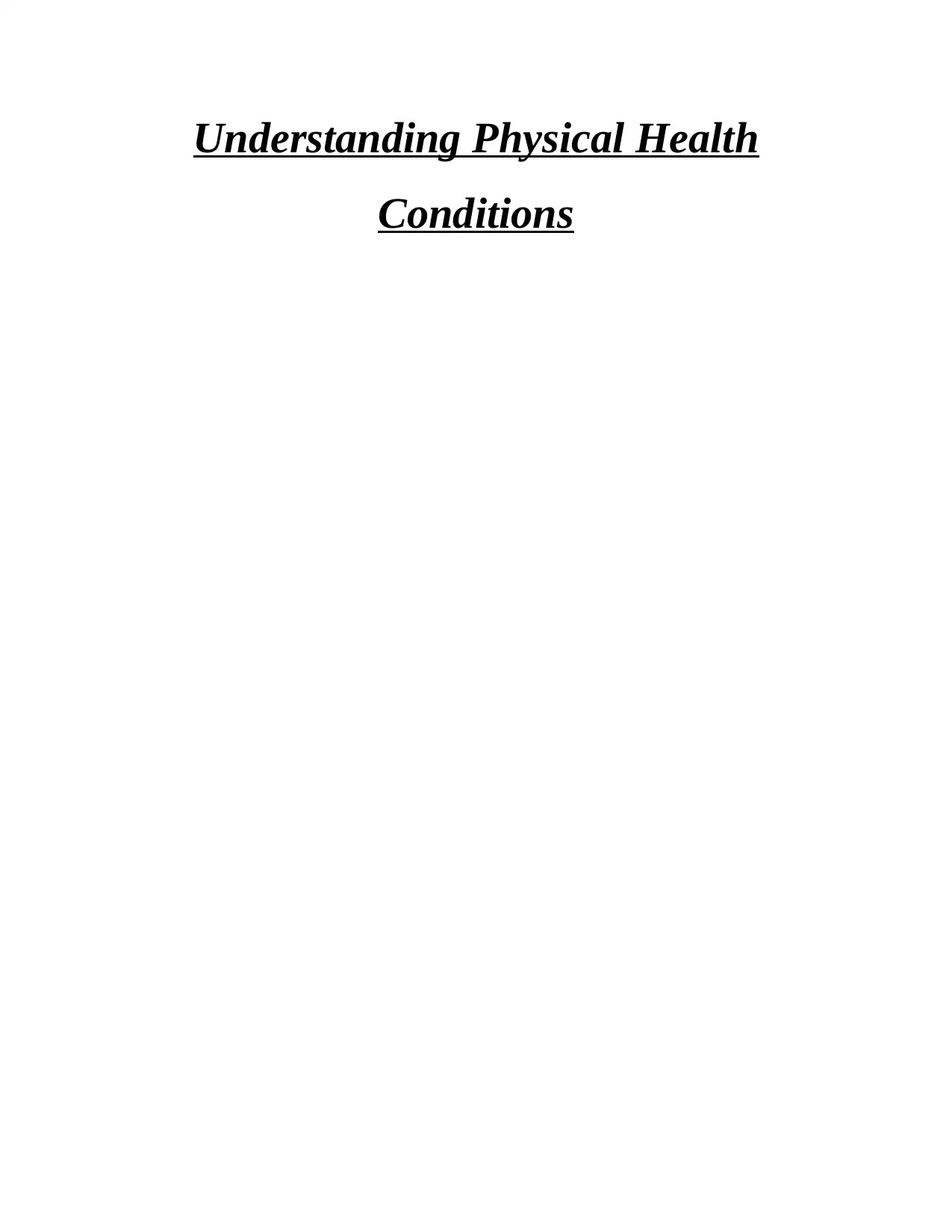
Understanding Physical Health
Conditions
Conditions
Secure Best Marks with AI Grader
Need help grading? Try our AI Grader for instant feedback on your assignments.
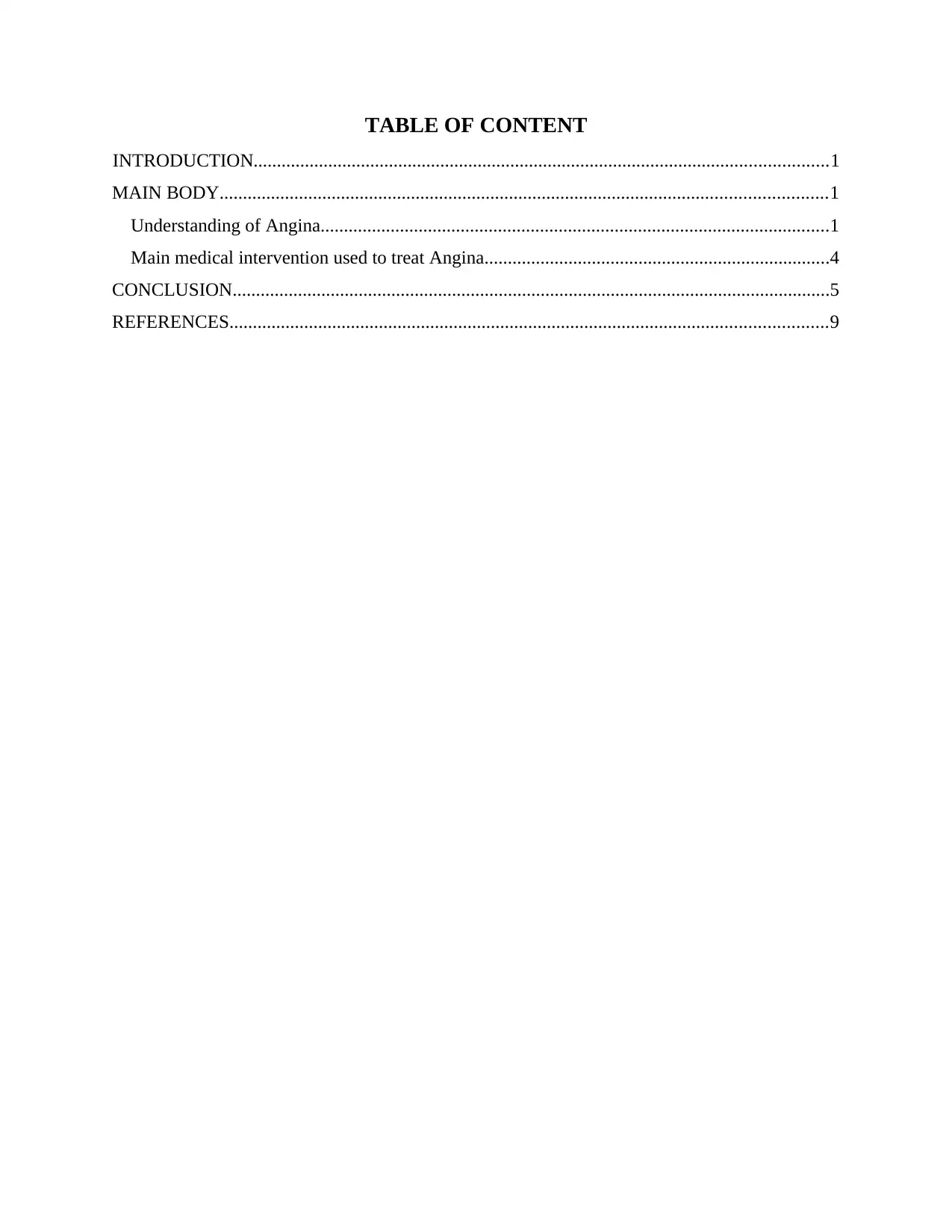
TABLE OF CONTENT
INTRODUCTION...........................................................................................................................1
MAIN BODY..................................................................................................................................1
Understanding of Angina.............................................................................................................1
Main medical intervention used to treat Angina..........................................................................4
CONCLUSION................................................................................................................................5
REFERENCES................................................................................................................................9
INTRODUCTION...........................................................................................................................1
MAIN BODY..................................................................................................................................1
Understanding of Angina.............................................................................................................1
Main medical intervention used to treat Angina..........................................................................4
CONCLUSION................................................................................................................................5
REFERENCES................................................................................................................................9
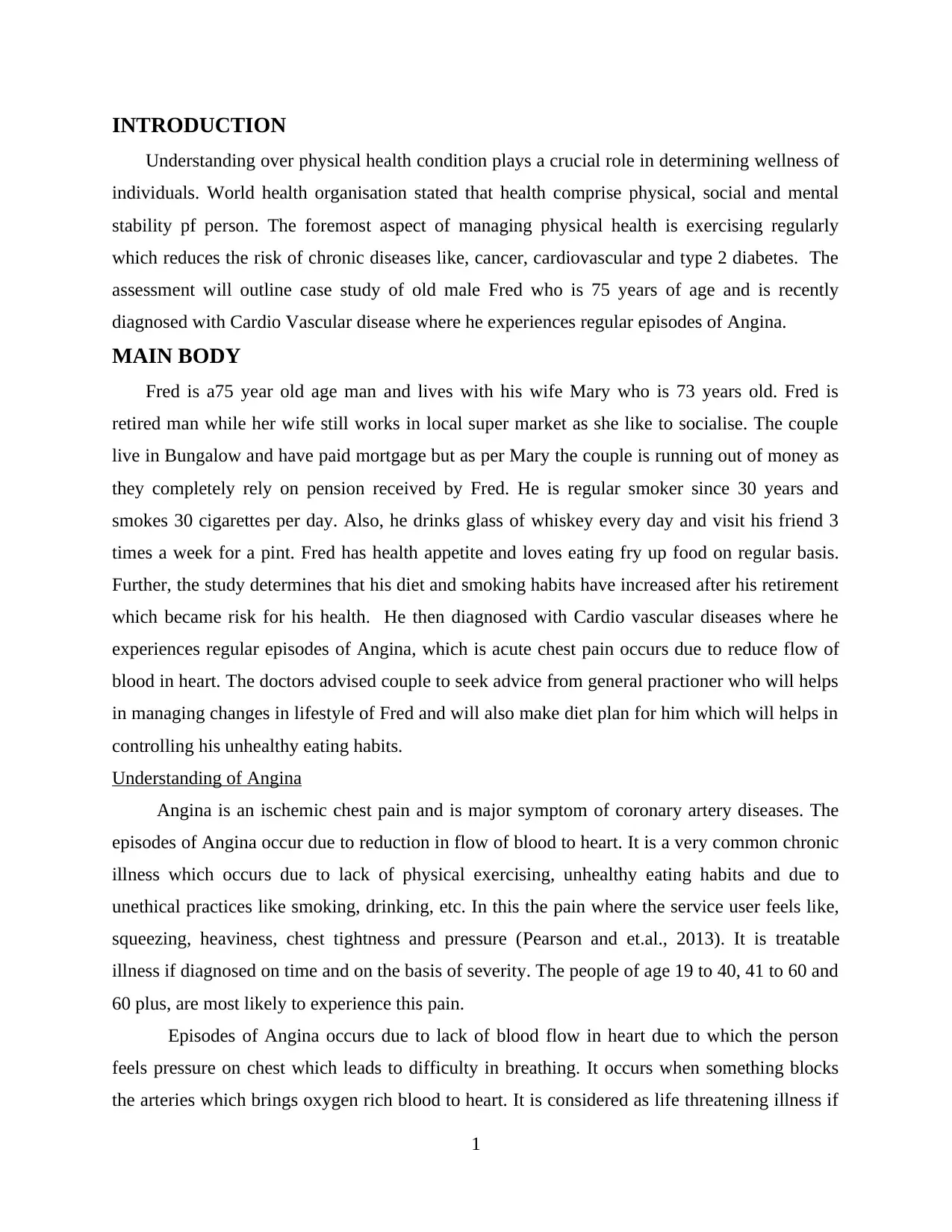
INTRODUCTION
Understanding over physical health condition plays a crucial role in determining wellness of
individuals. World health organisation stated that health comprise physical, social and mental
stability pf person. The foremost aspect of managing physical health is exercising regularly
which reduces the risk of chronic diseases like, cancer, cardiovascular and type 2 diabetes. The
assessment will outline case study of old male Fred who is 75 years of age and is recently
diagnosed with Cardio Vascular disease where he experiences regular episodes of Angina.
MAIN BODY
Fred is a75 year old age man and lives with his wife Mary who is 73 years old. Fred is
retired man while her wife still works in local super market as she like to socialise. The couple
live in Bungalow and have paid mortgage but as per Mary the couple is running out of money as
they completely rely on pension received by Fred. He is regular smoker since 30 years and
smokes 30 cigarettes per day. Also, he drinks glass of whiskey every day and visit his friend 3
times a week for a pint. Fred has health appetite and loves eating fry up food on regular basis.
Further, the study determines that his diet and smoking habits have increased after his retirement
which became risk for his health. He then diagnosed with Cardio vascular diseases where he
experiences regular episodes of Angina, which is acute chest pain occurs due to reduce flow of
blood in heart. The doctors advised couple to seek advice from general practioner who will helps
in managing changes in lifestyle of Fred and will also make diet plan for him which will helps in
controlling his unhealthy eating habits.
Understanding of Angina
Angina is an ischemic chest pain and is major symptom of coronary artery diseases. The
episodes of Angina occur due to reduction in flow of blood to heart. It is a very common chronic
illness which occurs due to lack of physical exercising, unhealthy eating habits and due to
unethical practices like smoking, drinking, etc. In this the pain where the service user feels like,
squeezing, heaviness, chest tightness and pressure (Pearson and et.al., 2013). It is treatable
illness if diagnosed on time and on the basis of severity. The people of age 19 to 40, 41 to 60 and
60 plus, are most likely to experience this pain.
Episodes of Angina occurs due to lack of blood flow in heart due to which the person
feels pressure on chest which leads to difficulty in breathing. It occurs when something blocks
the arteries which brings oxygen rich blood to heart. It is considered as life threatening illness if
1
Understanding over physical health condition plays a crucial role in determining wellness of
individuals. World health organisation stated that health comprise physical, social and mental
stability pf person. The foremost aspect of managing physical health is exercising regularly
which reduces the risk of chronic diseases like, cancer, cardiovascular and type 2 diabetes. The
assessment will outline case study of old male Fred who is 75 years of age and is recently
diagnosed with Cardio Vascular disease where he experiences regular episodes of Angina.
MAIN BODY
Fred is a75 year old age man and lives with his wife Mary who is 73 years old. Fred is
retired man while her wife still works in local super market as she like to socialise. The couple
live in Bungalow and have paid mortgage but as per Mary the couple is running out of money as
they completely rely on pension received by Fred. He is regular smoker since 30 years and
smokes 30 cigarettes per day. Also, he drinks glass of whiskey every day and visit his friend 3
times a week for a pint. Fred has health appetite and loves eating fry up food on regular basis.
Further, the study determines that his diet and smoking habits have increased after his retirement
which became risk for his health. He then diagnosed with Cardio vascular diseases where he
experiences regular episodes of Angina, which is acute chest pain occurs due to reduce flow of
blood in heart. The doctors advised couple to seek advice from general practioner who will helps
in managing changes in lifestyle of Fred and will also make diet plan for him which will helps in
controlling his unhealthy eating habits.
Understanding of Angina
Angina is an ischemic chest pain and is major symptom of coronary artery diseases. The
episodes of Angina occur due to reduction in flow of blood to heart. It is a very common chronic
illness which occurs due to lack of physical exercising, unhealthy eating habits and due to
unethical practices like smoking, drinking, etc. In this the pain where the service user feels like,
squeezing, heaviness, chest tightness and pressure (Pearson and et.al., 2013). It is treatable
illness if diagnosed on time and on the basis of severity. The people of age 19 to 40, 41 to 60 and
60 plus, are most likely to experience this pain.
Episodes of Angina occurs due to lack of blood flow in heart due to which the person
feels pressure on chest which leads to difficulty in breathing. It occurs when something blocks
the arteries which brings oxygen rich blood to heart. It is considered as life threatening illness if
1
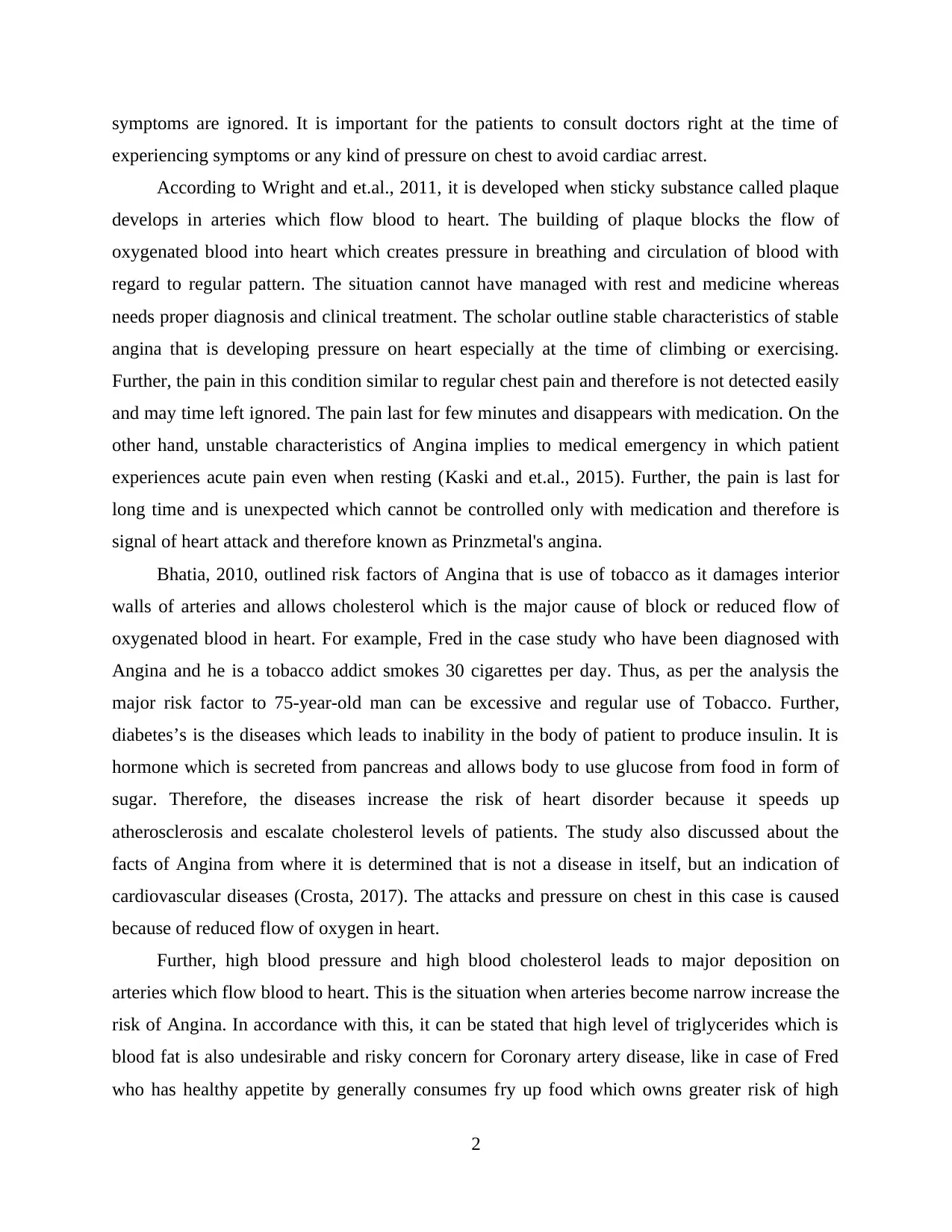
symptoms are ignored. It is important for the patients to consult doctors right at the time of
experiencing symptoms or any kind of pressure on chest to avoid cardiac arrest.
According to Wright and et.al., 2011, it is developed when sticky substance called plaque
develops in arteries which flow blood to heart. The building of plaque blocks the flow of
oxygenated blood into heart which creates pressure in breathing and circulation of blood with
regard to regular pattern. The situation cannot have managed with rest and medicine whereas
needs proper diagnosis and clinical treatment. The scholar outline stable characteristics of stable
angina that is developing pressure on heart especially at the time of climbing or exercising.
Further, the pain in this condition similar to regular chest pain and therefore is not detected easily
and may time left ignored. The pain last for few minutes and disappears with medication. On the
other hand, unstable characteristics of Angina implies to medical emergency in which patient
experiences acute pain even when resting (Kaski and et.al., 2015). Further, the pain is last for
long time and is unexpected which cannot be controlled only with medication and therefore is
signal of heart attack and therefore known as Prinzmetal's angina.
Bhatia, 2010, outlined risk factors of Angina that is use of tobacco as it damages interior
walls of arteries and allows cholesterol which is the major cause of block or reduced flow of
oxygenated blood in heart. For example, Fred in the case study who have been diagnosed with
Angina and he is a tobacco addict smokes 30 cigarettes per day. Thus, as per the analysis the
major risk factor to 75-year-old man can be excessive and regular use of Tobacco. Further,
diabetes’s is the diseases which leads to inability in the body of patient to produce insulin. It is
hormone which is secreted from pancreas and allows body to use glucose from food in form of
sugar. Therefore, the diseases increase the risk of heart disorder because it speeds up
atherosclerosis and escalate cholesterol levels of patients. The study also discussed about the
facts of Angina from where it is determined that is not a disease in itself, but an indication of
cardiovascular diseases (Crosta, 2017). The attacks and pressure on chest in this case is caused
because of reduced flow of oxygen in heart.
Further, high blood pressure and high blood cholesterol leads to major deposition on
arteries which flow blood to heart. This is the situation when arteries become narrow increase the
risk of Angina. In accordance with this, it can be stated that high level of triglycerides which is
blood fat is also undesirable and risky concern for Coronary artery disease, like in case of Fred
who has healthy appetite by generally consumes fry up food which owns greater risk of high
2
experiencing symptoms or any kind of pressure on chest to avoid cardiac arrest.
According to Wright and et.al., 2011, it is developed when sticky substance called plaque
develops in arteries which flow blood to heart. The building of plaque blocks the flow of
oxygenated blood into heart which creates pressure in breathing and circulation of blood with
regard to regular pattern. The situation cannot have managed with rest and medicine whereas
needs proper diagnosis and clinical treatment. The scholar outline stable characteristics of stable
angina that is developing pressure on heart especially at the time of climbing or exercising.
Further, the pain in this condition similar to regular chest pain and therefore is not detected easily
and may time left ignored. The pain last for few minutes and disappears with medication. On the
other hand, unstable characteristics of Angina implies to medical emergency in which patient
experiences acute pain even when resting (Kaski and et.al., 2015). Further, the pain is last for
long time and is unexpected which cannot be controlled only with medication and therefore is
signal of heart attack and therefore known as Prinzmetal's angina.
Bhatia, 2010, outlined risk factors of Angina that is use of tobacco as it damages interior
walls of arteries and allows cholesterol which is the major cause of block or reduced flow of
oxygenated blood in heart. For example, Fred in the case study who have been diagnosed with
Angina and he is a tobacco addict smokes 30 cigarettes per day. Thus, as per the analysis the
major risk factor to 75-year-old man can be excessive and regular use of Tobacco. Further,
diabetes’s is the diseases which leads to inability in the body of patient to produce insulin. It is
hormone which is secreted from pancreas and allows body to use glucose from food in form of
sugar. Therefore, the diseases increase the risk of heart disorder because it speeds up
atherosclerosis and escalate cholesterol levels of patients. The study also discussed about the
facts of Angina from where it is determined that is not a disease in itself, but an indication of
cardiovascular diseases (Crosta, 2017). The attacks and pressure on chest in this case is caused
because of reduced flow of oxygen in heart.
Further, high blood pressure and high blood cholesterol leads to major deposition on
arteries which flow blood to heart. This is the situation when arteries become narrow increase the
risk of Angina. In accordance with this, it can be stated that high level of triglycerides which is
blood fat is also undesirable and risky concern for Coronary artery disease, like in case of Fred
who has healthy appetite by generally consumes fry up food which owns greater risk of high
2
Secure Best Marks with AI Grader
Need help grading? Try our AI Grader for instant feedback on your assignments.
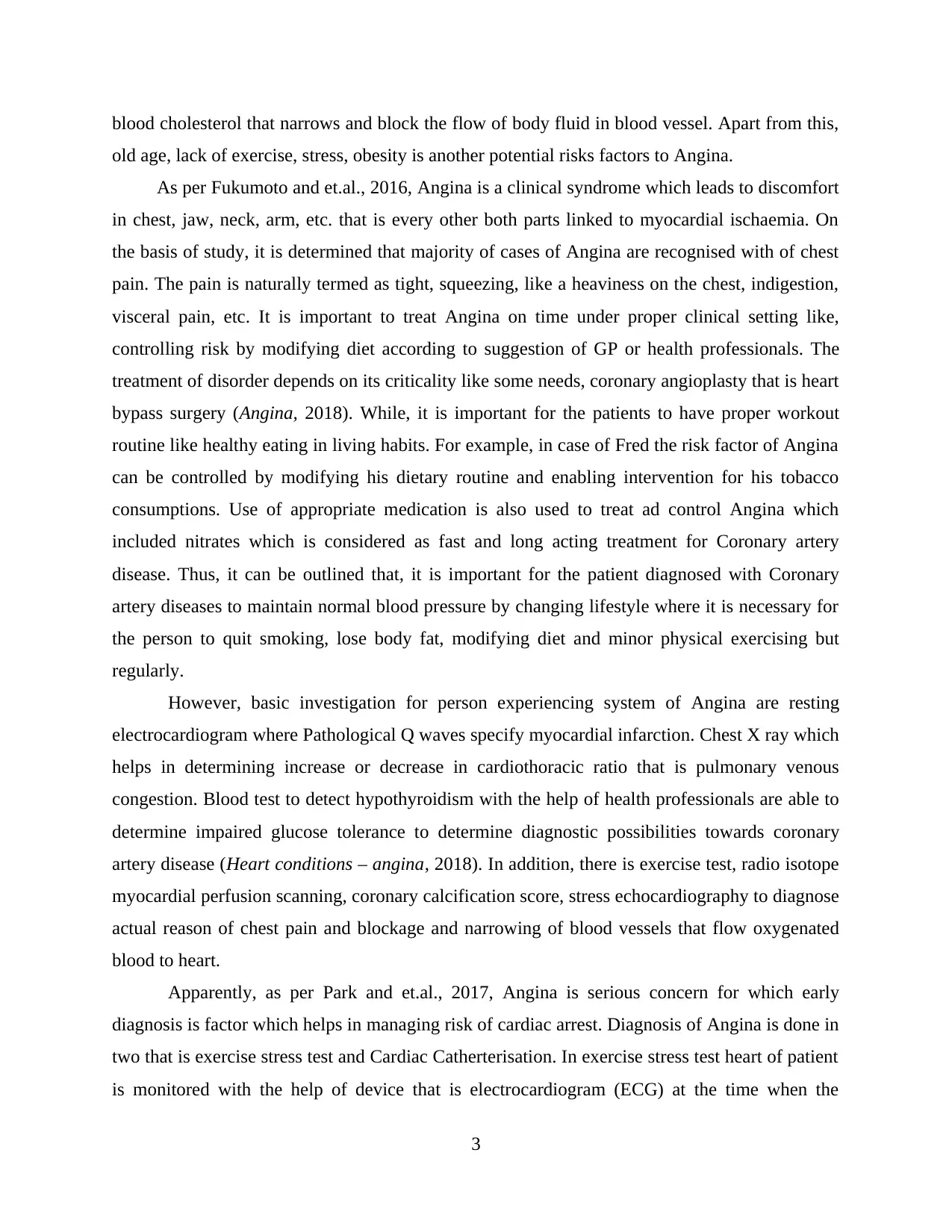
blood cholesterol that narrows and block the flow of body fluid in blood vessel. Apart from this,
old age, lack of exercise, stress, obesity is another potential risks factors to Angina.
As per Fukumoto and et.al., 2016, Angina is a clinical syndrome which leads to discomfort
in chest, jaw, neck, arm, etc. that is every other both parts linked to myocardial ischaemia. On
the basis of study, it is determined that majority of cases of Angina are recognised with of chest
pain. The pain is naturally termed as tight, squeezing, like a heaviness on the chest, indigestion,
visceral pain, etc. It is important to treat Angina on time under proper clinical setting like,
controlling risk by modifying diet according to suggestion of GP or health professionals. The
treatment of disorder depends on its criticality like some needs, coronary angioplasty that is heart
bypass surgery (Angina, 2018). While, it is important for the patients to have proper workout
routine like healthy eating in living habits. For example, in case of Fred the risk factor of Angina
can be controlled by modifying his dietary routine and enabling intervention for his tobacco
consumptions. Use of appropriate medication is also used to treat ad control Angina which
included nitrates which is considered as fast and long acting treatment for Coronary artery
disease. Thus, it can be outlined that, it is important for the patient diagnosed with Coronary
artery diseases to maintain normal blood pressure by changing lifestyle where it is necessary for
the person to quit smoking, lose body fat, modifying diet and minor physical exercising but
regularly.
However, basic investigation for person experiencing system of Angina are resting
electrocardiogram where Pathological Q waves specify myocardial infarction. Chest X ray which
helps in determining increase or decrease in cardiothoracic ratio that is pulmonary venous
congestion. Blood test to detect hypothyroidism with the help of health professionals are able to
determine impaired glucose tolerance to determine diagnostic possibilities towards coronary
artery disease (Heart conditions – angina, 2018). In addition, there is exercise test, radio isotope
myocardial perfusion scanning, coronary calcification score, stress echocardiography to diagnose
actual reason of chest pain and blockage and narrowing of blood vessels that flow oxygenated
blood to heart.
Apparently, as per Park and et.al., 2017, Angina is serious concern for which early
diagnosis is factor which helps in managing risk of cardiac arrest. Diagnosis of Angina is done in
two that is exercise stress test and Cardiac Catherterisation. In exercise stress test heart of patient
is monitored with the help of device that is electrocardiogram (ECG) at the time when the
3
old age, lack of exercise, stress, obesity is another potential risks factors to Angina.
As per Fukumoto and et.al., 2016, Angina is a clinical syndrome which leads to discomfort
in chest, jaw, neck, arm, etc. that is every other both parts linked to myocardial ischaemia. On
the basis of study, it is determined that majority of cases of Angina are recognised with of chest
pain. The pain is naturally termed as tight, squeezing, like a heaviness on the chest, indigestion,
visceral pain, etc. It is important to treat Angina on time under proper clinical setting like,
controlling risk by modifying diet according to suggestion of GP or health professionals. The
treatment of disorder depends on its criticality like some needs, coronary angioplasty that is heart
bypass surgery (Angina, 2018). While, it is important for the patients to have proper workout
routine like healthy eating in living habits. For example, in case of Fred the risk factor of Angina
can be controlled by modifying his dietary routine and enabling intervention for his tobacco
consumptions. Use of appropriate medication is also used to treat ad control Angina which
included nitrates which is considered as fast and long acting treatment for Coronary artery
disease. Thus, it can be outlined that, it is important for the patient diagnosed with Coronary
artery diseases to maintain normal blood pressure by changing lifestyle where it is necessary for
the person to quit smoking, lose body fat, modifying diet and minor physical exercising but
regularly.
However, basic investigation for person experiencing system of Angina are resting
electrocardiogram where Pathological Q waves specify myocardial infarction. Chest X ray which
helps in determining increase or decrease in cardiothoracic ratio that is pulmonary venous
congestion. Blood test to detect hypothyroidism with the help of health professionals are able to
determine impaired glucose tolerance to determine diagnostic possibilities towards coronary
artery disease (Heart conditions – angina, 2018). In addition, there is exercise test, radio isotope
myocardial perfusion scanning, coronary calcification score, stress echocardiography to diagnose
actual reason of chest pain and blockage and narrowing of blood vessels that flow oxygenated
blood to heart.
Apparently, as per Park and et.al., 2017, Angina is serious concern for which early
diagnosis is factor which helps in managing risk of cardiac arrest. Diagnosis of Angina is done in
two that is exercise stress test and Cardiac Catherterisation. In exercise stress test heart of patient
is monitored with the help of device that is electrocardiogram (ECG) at the time when the
3
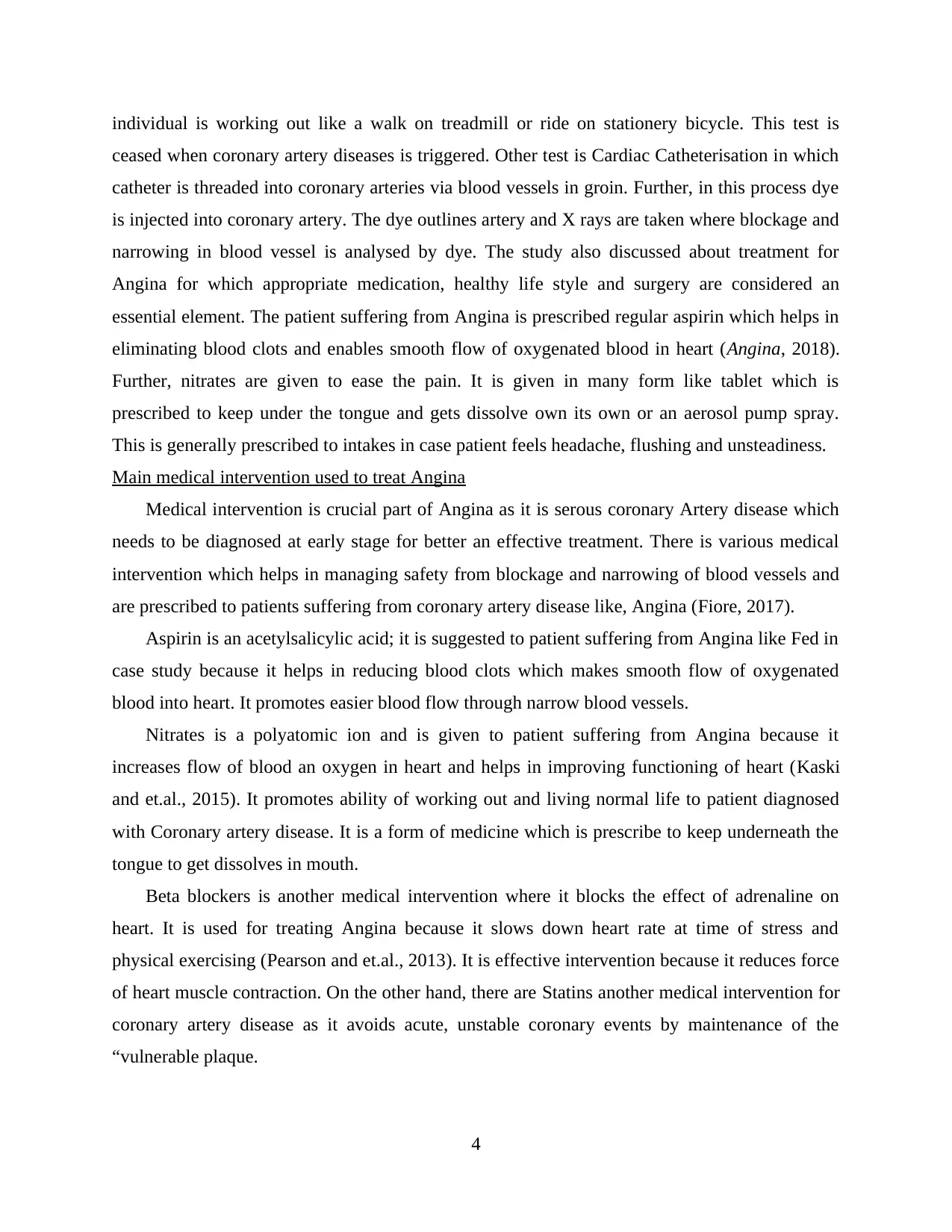
individual is working out like a walk on treadmill or ride on stationery bicycle. This test is
ceased when coronary artery diseases is triggered. Other test is Cardiac Catheterisation in which
catheter is threaded into coronary arteries via blood vessels in groin. Further, in this process dye
is injected into coronary artery. The dye outlines artery and X rays are taken where blockage and
narrowing in blood vessel is analysed by dye. The study also discussed about treatment for
Angina for which appropriate medication, healthy life style and surgery are considered an
essential element. The patient suffering from Angina is prescribed regular aspirin which helps in
eliminating blood clots and enables smooth flow of oxygenated blood in heart (Angina, 2018).
Further, nitrates are given to ease the pain. It is given in many form like tablet which is
prescribed to keep under the tongue and gets dissolve own its own or an aerosol pump spray.
This is generally prescribed to intakes in case patient feels headache, flushing and unsteadiness.
Main medical intervention used to treat Angina
Medical intervention is crucial part of Angina as it is serous coronary Artery disease which
needs to be diagnosed at early stage for better an effective treatment. There is various medical
intervention which helps in managing safety from blockage and narrowing of blood vessels and
are prescribed to patients suffering from coronary artery disease like, Angina (Fiore, 2017).
Aspirin is an acetylsalicylic acid; it is suggested to patient suffering from Angina like Fed in
case study because it helps in reducing blood clots which makes smooth flow of oxygenated
blood into heart. It promotes easier blood flow through narrow blood vessels.
Nitrates is a polyatomic ion and is given to patient suffering from Angina because it
increases flow of blood an oxygen in heart and helps in improving functioning of heart (Kaski
and et.al., 2015). It promotes ability of working out and living normal life to patient diagnosed
with Coronary artery disease. It is a form of medicine which is prescribe to keep underneath the
tongue to get dissolves in mouth.
Beta blockers is another medical intervention where it blocks the effect of adrenaline on
heart. It is used for treating Angina because it slows down heart rate at time of stress and
physical exercising (Pearson and et.al., 2013). It is effective intervention because it reduces force
of heart muscle contraction. On the other hand, there are Statins another medical intervention for
coronary artery disease as it avoids acute, unstable coronary events by maintenance of the
“vulnerable plaque.
4
ceased when coronary artery diseases is triggered. Other test is Cardiac Catheterisation in which
catheter is threaded into coronary arteries via blood vessels in groin. Further, in this process dye
is injected into coronary artery. The dye outlines artery and X rays are taken where blockage and
narrowing in blood vessel is analysed by dye. The study also discussed about treatment for
Angina for which appropriate medication, healthy life style and surgery are considered an
essential element. The patient suffering from Angina is prescribed regular aspirin which helps in
eliminating blood clots and enables smooth flow of oxygenated blood in heart (Angina, 2018).
Further, nitrates are given to ease the pain. It is given in many form like tablet which is
prescribed to keep under the tongue and gets dissolve own its own or an aerosol pump spray.
This is generally prescribed to intakes in case patient feels headache, flushing and unsteadiness.
Main medical intervention used to treat Angina
Medical intervention is crucial part of Angina as it is serous coronary Artery disease which
needs to be diagnosed at early stage for better an effective treatment. There is various medical
intervention which helps in managing safety from blockage and narrowing of blood vessels and
are prescribed to patients suffering from coronary artery disease like, Angina (Fiore, 2017).
Aspirin is an acetylsalicylic acid; it is suggested to patient suffering from Angina like Fed in
case study because it helps in reducing blood clots which makes smooth flow of oxygenated
blood into heart. It promotes easier blood flow through narrow blood vessels.
Nitrates is a polyatomic ion and is given to patient suffering from Angina because it
increases flow of blood an oxygen in heart and helps in improving functioning of heart (Kaski
and et.al., 2015). It promotes ability of working out and living normal life to patient diagnosed
with Coronary artery disease. It is a form of medicine which is prescribe to keep underneath the
tongue to get dissolves in mouth.
Beta blockers is another medical intervention where it blocks the effect of adrenaline on
heart. It is used for treating Angina because it slows down heart rate at time of stress and
physical exercising (Pearson and et.al., 2013). It is effective intervention because it reduces force
of heart muscle contraction. On the other hand, there are Statins another medical intervention for
coronary artery disease as it avoids acute, unstable coronary events by maintenance of the
“vulnerable plaque.
4
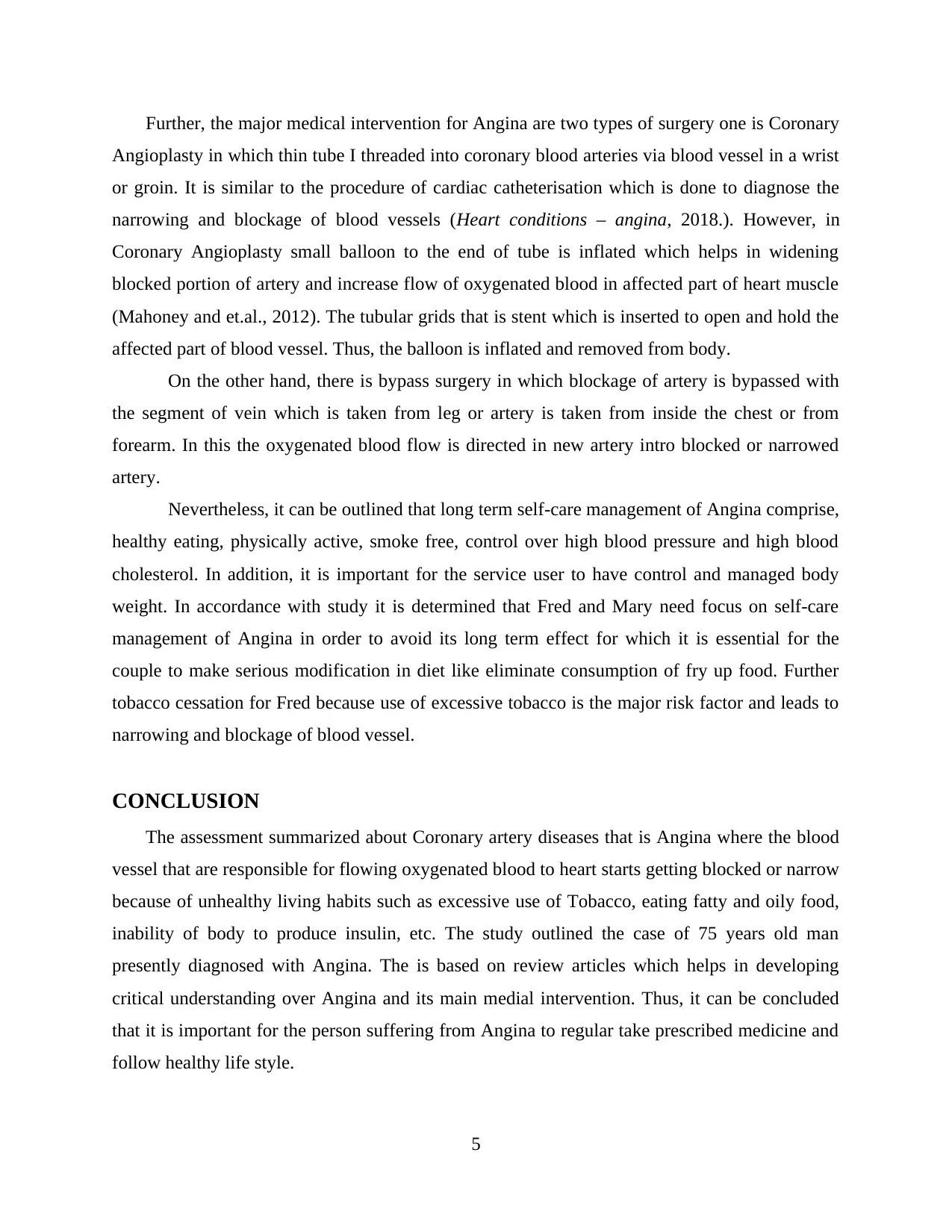
Further, the major medical intervention for Angina are two types of surgery one is Coronary
Angioplasty in which thin tube I threaded into coronary blood arteries via blood vessel in a wrist
or groin. It is similar to the procedure of cardiac catheterisation which is done to diagnose the
narrowing and blockage of blood vessels (Heart conditions – angina, 2018.). However, in
Coronary Angioplasty small balloon to the end of tube is inflated which helps in widening
blocked portion of artery and increase flow of oxygenated blood in affected part of heart muscle
(Mahoney and et.al., 2012). The tubular grids that is stent which is inserted to open and hold the
affected part of blood vessel. Thus, the balloon is inflated and removed from body.
On the other hand, there is bypass surgery in which blockage of artery is bypassed with
the segment of vein which is taken from leg or artery is taken from inside the chest or from
forearm. In this the oxygenated blood flow is directed in new artery intro blocked or narrowed
artery.
Nevertheless, it can be outlined that long term self-care management of Angina comprise,
healthy eating, physically active, smoke free, control over high blood pressure and high blood
cholesterol. In addition, it is important for the service user to have control and managed body
weight. In accordance with study it is determined that Fred and Mary need focus on self-care
management of Angina in order to avoid its long term effect for which it is essential for the
couple to make serious modification in diet like eliminate consumption of fry up food. Further
tobacco cessation for Fred because use of excessive tobacco is the major risk factor and leads to
narrowing and blockage of blood vessel.
CONCLUSION
The assessment summarized about Coronary artery diseases that is Angina where the blood
vessel that are responsible for flowing oxygenated blood to heart starts getting blocked or narrow
because of unhealthy living habits such as excessive use of Tobacco, eating fatty and oily food,
inability of body to produce insulin, etc. The study outlined the case of 75 years old man
presently diagnosed with Angina. The is based on review articles which helps in developing
critical understanding over Angina and its main medial intervention. Thus, it can be concluded
that it is important for the person suffering from Angina to regular take prescribed medicine and
follow healthy life style.
5
Angioplasty in which thin tube I threaded into coronary blood arteries via blood vessel in a wrist
or groin. It is similar to the procedure of cardiac catheterisation which is done to diagnose the
narrowing and blockage of blood vessels (Heart conditions – angina, 2018.). However, in
Coronary Angioplasty small balloon to the end of tube is inflated which helps in widening
blocked portion of artery and increase flow of oxygenated blood in affected part of heart muscle
(Mahoney and et.al., 2012). The tubular grids that is stent which is inserted to open and hold the
affected part of blood vessel. Thus, the balloon is inflated and removed from body.
On the other hand, there is bypass surgery in which blockage of artery is bypassed with
the segment of vein which is taken from leg or artery is taken from inside the chest or from
forearm. In this the oxygenated blood flow is directed in new artery intro blocked or narrowed
artery.
Nevertheless, it can be outlined that long term self-care management of Angina comprise,
healthy eating, physically active, smoke free, control over high blood pressure and high blood
cholesterol. In addition, it is important for the service user to have control and managed body
weight. In accordance with study it is determined that Fred and Mary need focus on self-care
management of Angina in order to avoid its long term effect for which it is essential for the
couple to make serious modification in diet like eliminate consumption of fry up food. Further
tobacco cessation for Fred because use of excessive tobacco is the major risk factor and leads to
narrowing and blockage of blood vessel.
CONCLUSION
The assessment summarized about Coronary artery diseases that is Angina where the blood
vessel that are responsible for flowing oxygenated blood to heart starts getting blocked or narrow
because of unhealthy living habits such as excessive use of Tobacco, eating fatty and oily food,
inability of body to produce insulin, etc. The study outlined the case of 75 years old man
presently diagnosed with Angina. The is based on review articles which helps in developing
critical understanding over Angina and its main medial intervention. Thus, it can be concluded
that it is important for the person suffering from Angina to regular take prescribed medicine and
follow healthy life style.
5
Paraphrase This Document
Need a fresh take? Get an instant paraphrase of this document with our AI Paraphraser
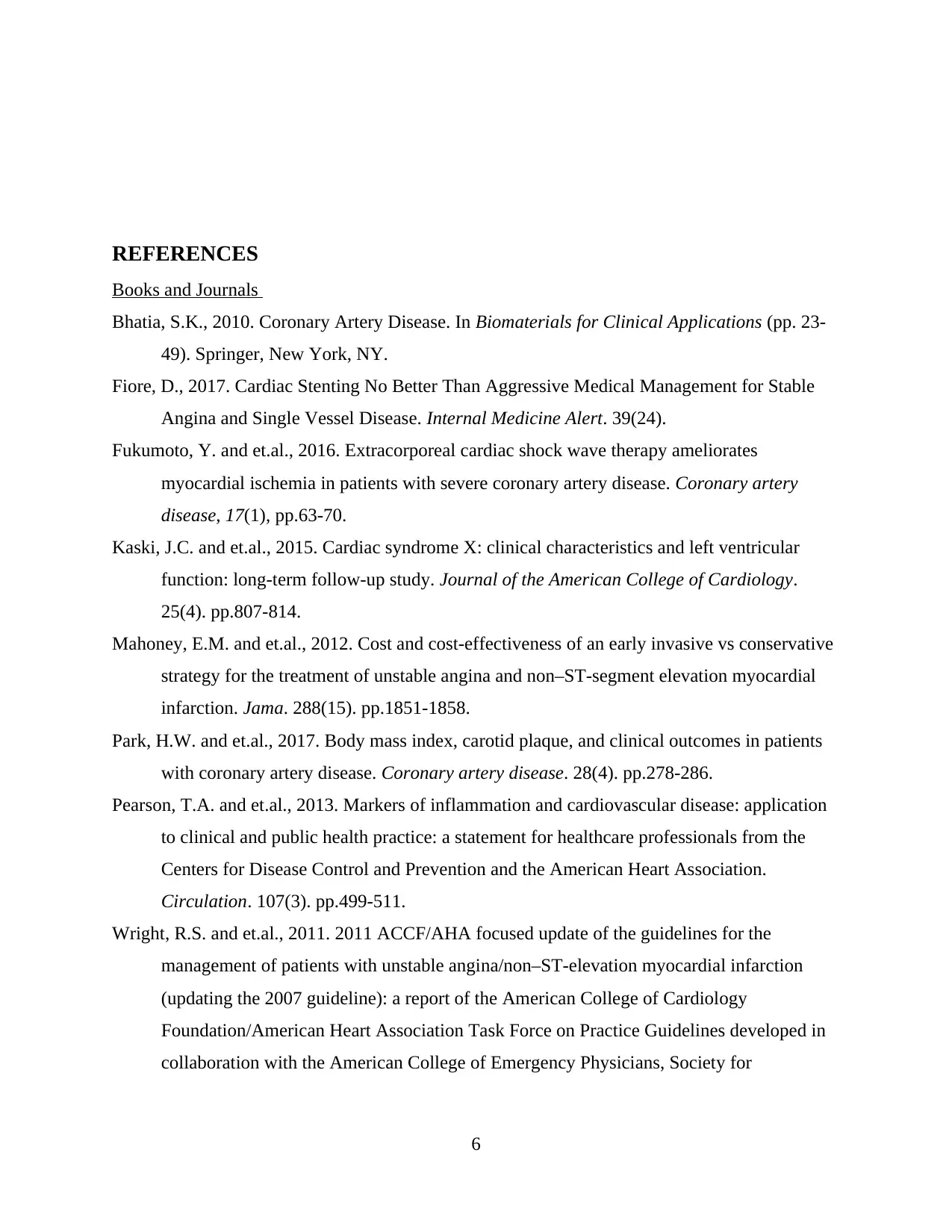
REFERENCES
Books and Journals
Bhatia, S.K., 2010. Coronary Artery Disease. In Biomaterials for Clinical Applications (pp. 23-
49). Springer, New York, NY.
Fiore, D., 2017. Cardiac Stenting No Better Than Aggressive Medical Management for Stable
Angina and Single Vessel Disease. Internal Medicine Alert. 39(24).
Fukumoto, Y. and et.al., 2016. Extracorporeal cardiac shock wave therapy ameliorates
myocardial ischemia in patients with severe coronary artery disease. Coronary artery
disease, 17(1), pp.63-70.
Kaski, J.C. and et.al., 2015. Cardiac syndrome X: clinical characteristics and left ventricular
function: long-term follow-up study. Journal of the American College of Cardiology.
25(4). pp.807-814.
Mahoney, E.M. and et.al., 2012. Cost and cost-effectiveness of an early invasive vs conservative
strategy for the treatment of unstable angina and non–ST-segment elevation myocardial
infarction. Jama. 288(15). pp.1851-1858.
Park, H.W. and et.al., 2017. Body mass index, carotid plaque, and clinical outcomes in patients
with coronary artery disease. Coronary artery disease. 28(4). pp.278-286.
Pearson, T.A. and et.al., 2013. Markers of inflammation and cardiovascular disease: application
to clinical and public health practice: a statement for healthcare professionals from the
Centers for Disease Control and Prevention and the American Heart Association.
Circulation. 107(3). pp.499-511.
Wright, R.S. and et.al., 2011. 2011 ACCF/AHA focused update of the guidelines for the
management of patients with unstable angina/non–ST-elevation myocardial infarction
(updating the 2007 guideline): a report of the American College of Cardiology
Foundation/American Heart Association Task Force on Practice Guidelines developed in
collaboration with the American College of Emergency Physicians, Society for
6
Books and Journals
Bhatia, S.K., 2010. Coronary Artery Disease. In Biomaterials for Clinical Applications (pp. 23-
49). Springer, New York, NY.
Fiore, D., 2017. Cardiac Stenting No Better Than Aggressive Medical Management for Stable
Angina and Single Vessel Disease. Internal Medicine Alert. 39(24).
Fukumoto, Y. and et.al., 2016. Extracorporeal cardiac shock wave therapy ameliorates
myocardial ischemia in patients with severe coronary artery disease. Coronary artery
disease, 17(1), pp.63-70.
Kaski, J.C. and et.al., 2015. Cardiac syndrome X: clinical characteristics and left ventricular
function: long-term follow-up study. Journal of the American College of Cardiology.
25(4). pp.807-814.
Mahoney, E.M. and et.al., 2012. Cost and cost-effectiveness of an early invasive vs conservative
strategy for the treatment of unstable angina and non–ST-segment elevation myocardial
infarction. Jama. 288(15). pp.1851-1858.
Park, H.W. and et.al., 2017. Body mass index, carotid plaque, and clinical outcomes in patients
with coronary artery disease. Coronary artery disease. 28(4). pp.278-286.
Pearson, T.A. and et.al., 2013. Markers of inflammation and cardiovascular disease: application
to clinical and public health practice: a statement for healthcare professionals from the
Centers for Disease Control and Prevention and the American Heart Association.
Circulation. 107(3). pp.499-511.
Wright, R.S. and et.al., 2011. 2011 ACCF/AHA focused update of the guidelines for the
management of patients with unstable angina/non–ST-elevation myocardial infarction
(updating the 2007 guideline): a report of the American College of Cardiology
Foundation/American Heart Association Task Force on Practice Guidelines developed in
collaboration with the American College of Emergency Physicians, Society for
6
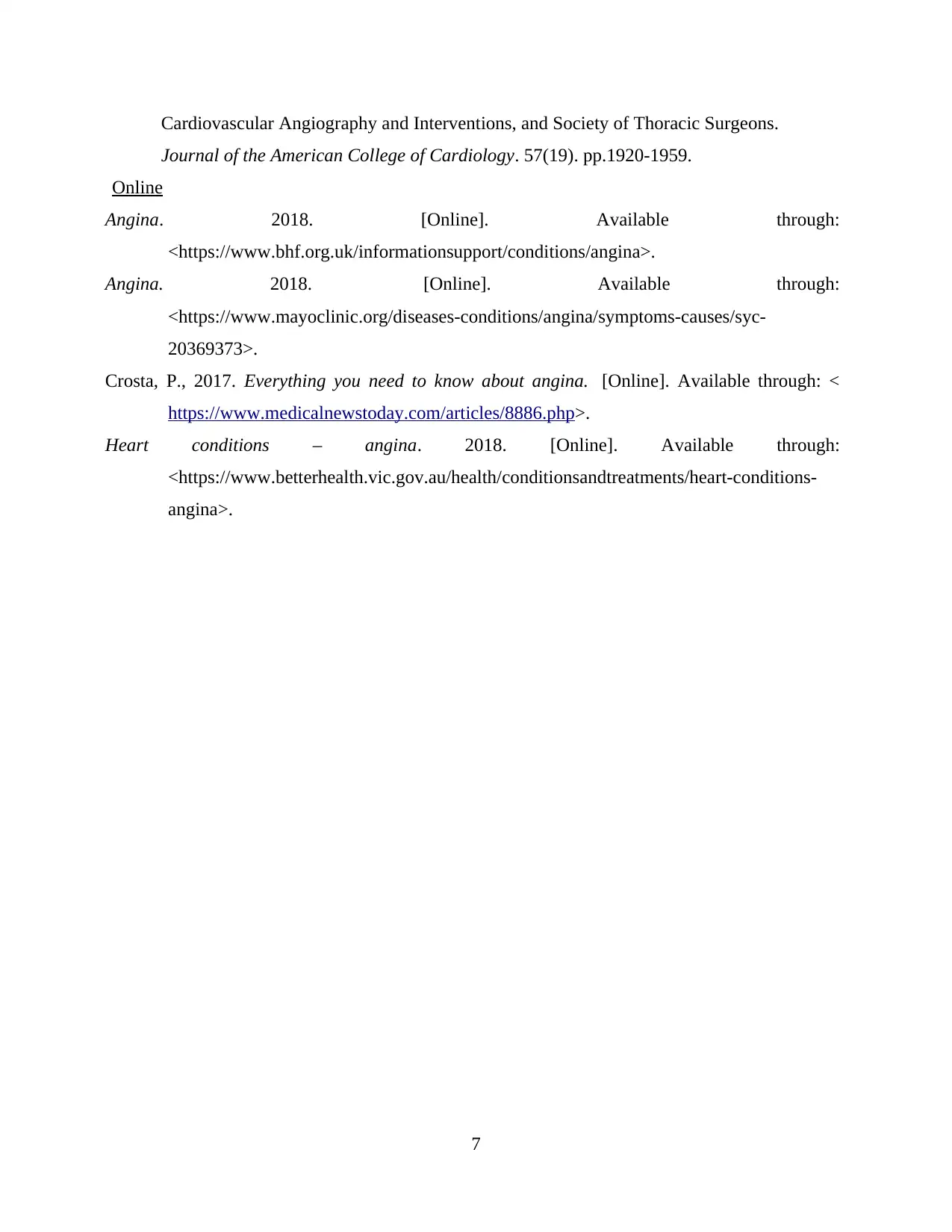
Cardiovascular Angiography and Interventions, and Society of Thoracic Surgeons.
Journal of the American College of Cardiology. 57(19). pp.1920-1959.
Online
Angina. 2018. [Online]. Available through:
<https://www.bhf.org.uk/informationsupport/conditions/angina>.
Angina. 2018. [Online]. Available through:
<https://www.mayoclinic.org/diseases-conditions/angina/symptoms-causes/syc-
20369373>.
Crosta, P., 2017. Everything you need to know about angina. [Online]. Available through: <
https://www.medicalnewstoday.com/articles/8886.php>.
Heart conditions – angina. 2018. [Online]. Available through:
<https://www.betterhealth.vic.gov.au/health/conditionsandtreatments/heart-conditions-
angina>.
7
Journal of the American College of Cardiology. 57(19). pp.1920-1959.
Online
Angina. 2018. [Online]. Available through:
<https://www.bhf.org.uk/informationsupport/conditions/angina>.
Angina. 2018. [Online]. Available through:
<https://www.mayoclinic.org/diseases-conditions/angina/symptoms-causes/syc-
20369373>.
Crosta, P., 2017. Everything you need to know about angina. [Online]. Available through: <
https://www.medicalnewstoday.com/articles/8886.php>.
Heart conditions – angina. 2018. [Online]. Available through:
<https://www.betterhealth.vic.gov.au/health/conditionsandtreatments/heart-conditions-
angina>.
7
1 out of 9
Related Documents
Your All-in-One AI-Powered Toolkit for Academic Success.
+13062052269
info@desklib.com
Available 24*7 on WhatsApp / Email
![[object Object]](/_next/static/media/star-bottom.7253800d.svg)
Unlock your academic potential
© 2024 | Zucol Services PVT LTD | All rights reserved.





